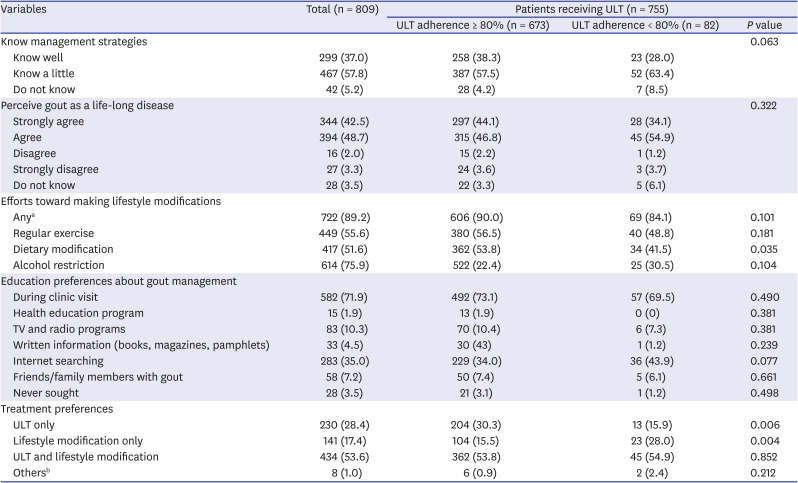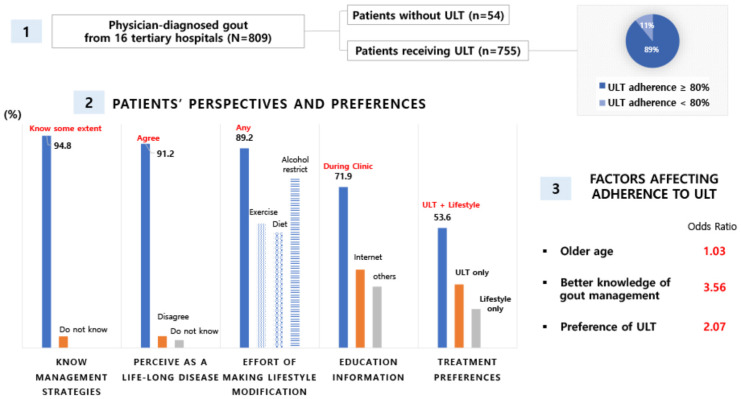1. Chen-Xu M, Yokose C, Rai SK, Pillinger MH, Choi HK. Contemporary prevalence of gout and hyperuricemia in the United States and decadal trends: the National Health and Nutrition Examination Survey, 2007–2016. Arthritis Rheumatol. 2019; 71(6):991–999. PMID:
30618180.

2. Mattiuzzi C, Lippi G. Recent updates on worldwide gout epidemiology. Clin Rheumatol. 2020; 39(4):1061–1063. PMID:
31836936.

3. Park JS, Kang M, Song JS, Lim HS, Lee CH. Trends of gout prevalence in South Korea based on medical utilization: a National Health Insurance Service Database (2002–2015). J Rheum Dis. 2020; 27(3):174–181.

4. Dalbeth N, Choi HK, Joosten LA, Khanna PP, Matsuo H, Perez-Ruiz F, et al. Gout. Nat Rev Dis Primers. 2019; 5(1):69. PMID:
31558729.

5. Richette P, Doherty M, Pascual E, Barskova V, Becce F, Castañeda-Sanabria J, et al. 2016 updated EULAR evidence-based recommendations for the management of gout. Ann Rheum Dis. 2017; 76(1):29–42. PMID:
27457514.

6. Kiltz U, Smolen J, Bardin T, Cohen Solal A, Dalbeth N, Doherty M, et al. Treat-to-target (T2T) recommendations for gout. Ann Rheum Dis. 2017; 76(4):632–638. PMID:
27658678.

7. Doherty M, Jansen TL, Nuki G, Pascual E, Perez-Ruiz F, Punzi L, et al. Gout: why is this curable disease so seldom cured? Ann Rheum Dis. 2012; 71(11):1765–1770. PMID:
22863577.

8. Kuo CF, Grainge MJ, Mallen C, Zhang W, Doherty M. Rising burden of gout in the UK but continuing suboptimal management: a nationwide population study. Ann Rheum Dis. 2015; 74(4):661–667. PMID:
24431399.

9. Hui M, Carr A, Cameron S, Davenport G, Doherty M, Forrester H, et al. The British Society for Rheumatology guideline for the management of gout. Rheumatology (Oxford). 2017; 56(7):e1–20. PMID:
28549177.

10. FitzGerald JD, Dalbeth N, Mikuls T, Brignardello-Petersen R, Guyatt G, Abeles AM, et al. 2020 American College of Rheumatology guideline for the management of gout. Arthritis Care Res (Hoboken). 2020; 72(6):744–760. PMID:
32391934.

11. Jung-Soo S, Jae-Bum J. Korean guidelines for tailored management of gout. J Rheum Dis. 2013; 20(5):280–285.

12. Scheepers LE, van Onna M, Stehouwer CD, Singh JA, Arts IC, Boonen A. Medication adherence among patients with gout: a systematic review and meta-analysis. Semin Arthritis Rheum. 2018; 47(5):689–702. PMID:
29198878.

13. Yin R, Li L, Zhang G, Cui Y, Zhang L, Zhang Q, et al. Rate of adherence to urate-lowering therapy among patients with gout: a systematic review and meta-analysis. BMJ Open. 2018; 8(4):e017542.

14. Briesacher BA, Andrade SE, Fouayzi H, Chan KA. Comparison of drug adherence rates among patients with seven different medical conditions. Pharmacotherapy. 2008; 28(4):437–443. PMID:
18363527.

15. Doherty M, Jenkins W, Richardson H, Sarmanova A, Abhishek A, Ashton D, et al. Efficacy and cost-effectiveness of nurse-led care involving education and engagement of patients and a treat-to-target urate-lowering strategy versus usual care for gout: a randomised controlled trial. Lancet. 2018; 392(10156):1403–1412. PMID:
30343856.

16. Mikuls TR, Cheetham TC, Levy GD, Rashid N, Kerimian A, Low KJ, et al. Adherence and outcomes with urate-lowering therapy: a site-randomized trial. Am J Med. 2019; 132(3):354–361. PMID:
30503879.

17. Dalbeth N, Petrie KJ, House M, Chong J, Leung W, Chegudi R, et al. Illness perceptions in patients with gout and the relationship with progression of musculoskeletal disability. Arthritis Care Res (Hoboken). 2011; 63(11):1605–1612. PMID:
22034122.

18. Krahn M, Naglie G. The next step in guideline development: incorporating patient preferences. JAMA. 2008; 300(4):436–438. PMID:
18647988.
19. Fraenkel L, Miller AS, Clayton K, Crow-Hercher R, Hazel S, Johnson B, et al. When patients write the guidelines: patient panel recommendations for the treatment of rheumatoid arthritis. Arthritis Care Res (Hoboken). 2016; 68(1):26–35. PMID:
26545701.

20. Goodman SM, Miller AS, Turgunbaev M, Guyatt G, Yates A, Springer B, et al. Clinical practice guidelines: incorporating input from a patient panel. Arthritis Care Res (Hoboken). 2017; 69(8):1125–1130. PMID:
28620968.

21. Singh JA, Neogi T, FitzGerald JD. Patient perspectives on gout and gout treatments: a patient panel discussion that informed the 2020 American College of Rheumatology treatment guideline. ACR Open Rheumatol. 2020; 2(12):725–733. PMID:
33222416.

22. De Vera MA, Marcotte G, Rai S, Galo JS, Bhole V. Medication adherence in gout: a systematic review. Arthritis Care Res (Hoboken). 2014; 66(10):1551–1559. PMID:
24692321.

23. Kim JW, Kwak SG, Park SH. Prescription pattern of urate-lowering therapy in Korean gout patients: data from the national health claims database. Korean J Intern Med (Korean Assoc Intern Med). 2018; 33(1):228–229.

24. Spencer K, Carr A, Doherty M. Patient and provider barriers to effective management of gout in general practice: a qualitative study. Ann Rheum Dis. 2012; 71(9):1490–1495. PMID:
22440822.
25. Morris C, Macdonald L, Stubbe M, Dowell A. “It's complicated” - talking about gout medicines in primary care consultations: a qualitative study. BMC Fam Pract. 2016; 17(1):114. PMID:
27542754.

26. Rees F, Jenkins W, Doherty M. Patients with gout adhere to curative treatment if informed appropriately: proof-of-concept observational study. Ann Rheum Dis. 2013; 72(6):826–830. PMID:
22679303.

27. Abhishek A, Jenkins W, La-Crette J, Fernandes G, Doherty M. Long-term persistence and adherence on urate-lowering treatment can be maintained in primary care-5-year follow-up of a proof-of-concept study. Rheumatology (Oxford). 2017; 56(4):529–533. PMID:
28082620.

28. Joo K, Kwon SR, Lim MJ, Jung KH, Joo H, Park W. Prevention of comorbidity and acute attack of gout by uric acid lowering therapy. J Korean Med Sci. 2014; 29(5):657–661. PMID:
24851021.

29. Singh JA, Shah N, Edwards NL. A cross-sectional internet-based patient survey of the management strategies for gout. BMC Complement Altern Med. 2016; 16(1):90. PMID:
26931313.








 PDF
PDF Citation
Citation Print
Print




 XML Download
XML Download